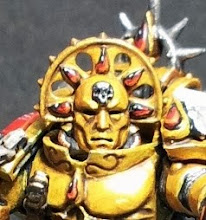
壬生義士伝 is set in the last days of the Tokugawa Shogunate, during which a wave of reform, sparked by the Emperor Koumei, resulted a state of civil war, with samurai siding either with the Emperor or, like the Shinsengumi, with the Shogun. The movie largely revolves around the lives of two ronin, members of the Shinsengumi : Saitou Hajime (斎藤 一) and Yoshimura Kanichiro.
 If you're anything like me, you may be familiar with Saitou from his appearances in Rurouni Kenshin. If not, well, meh. Saitou's being Saitou. He did really exist, and did indeed have a reputation for being a stone-faced, cold-blooded killer with a rock-solid sense of justice. Saitou is also reputed to have been left-handed, though whether this is due to him favouring the quick, left-handed thrust of itto-ryu swordsmanship or actually wielding the katana left-handed, as depicted in 壬生義士伝, isn't too clear.
If you're anything like me, you may be familiar with Saitou from his appearances in Rurouni Kenshin. If not, well, meh. Saitou's being Saitou. He did really exist, and did indeed have a reputation for being a stone-faced, cold-blooded killer with a rock-solid sense of justice. Saitou is also reputed to have been left-handed, though whether this is due to him favouring the quick, left-handed thrust of itto-ryu swordsmanship or actually wielding the katana left-handed, as depicted in 壬生義士伝, isn't too clear.Yoshimura Kanichiro is completely fictitious, but that doesn't make the character any less interesting. When we first see him in the movie, we find in him both a masterful swordsman and, oddly enough, a money-grubbing country bumpkin who can't stop talking about his home province. What I can say, without giving too much away, is that the apparent avarice comes with a story behind it. A very, very sad story.
Kenshin fans can expect to hear familiar names, but not see familiar faces. For instance, Okita Souji, the genius Shinsengumi swordsman who expired of tuberculosis makes an appearance:
 Not quite the same as the Kenshin version:
Not quite the same as the Kenshin version: As I mentioned previously, appreciate this movie requires that one understand a little about the cultural and historical background in which it is set. Take, for instance, this scene:
As I mentioned previously, appreciate this movie requires that one understand a little about the cultural and historical background in which it is set. Take, for instance, this scene: Against overwhelming odds, Yoshimura draws both blades and announces his name and allegiance. The big deal? Well, long story short...
Against overwhelming odds, Yoshimura draws both blades and announces his name and allegiance. The big deal? Well, long story short...On the swords: The katana was designed to held in both hands. Rare indeed was the hero who wielded both blades skilfully at once, and Yoshimura was not one of them. The simple explanation is that, back then, life was cheap, honour was everything, and for a warrior, there was little more shameful than to die with a weapon still in its sheath. In the face of certain death, rather than try to up your odds of survival by keeping to the one blade that you're good at, it was far better to guarantee that you die with both blades drawn.
Name and allegiance: Announcing these things held a special significance in this context. Both the forces of the Shogun and Emperor believed they were each serving Japan best in an era where the separate feudal domains were, after centuries of war, coalescing into a united Japan. In this scene, Imperialist reinforcements arrived, bearing the Emperor's personal banners, loudly proclaiming that traitors would be shown no mercy. What shocked the Shogunate forces most in this skirmish was being branded as traitors, and their resolve thus wavered. Not Yoshimura, who, having left his master to serve with the Shinsengumi, refused to betray another master. This was no longer a matter of who's right or wrong, but a matter of a samurai's duty to his master, whether that master take the form of a feudal lord, the Emperor, an ideal or even Bushido itself.
 壬生義士伝 offers many, many more such displays of Bushido spirit*, and I'd strongly recommend reading up briefly on Bushido and the Bakumatsu period before watching it. I for one adore this movie, and have watched it far too many times. Can't bear to watch it now. Kanashi sugite mireba naku da kara... <:')
壬生義士伝 offers many, many more such displays of Bushido spirit*, and I'd strongly recommend reading up briefly on Bushido and the Bakumatsu period before watching it. I for one adore this movie, and have watched it far too many times. Can't bear to watch it now. Kanashi sugite mireba naku da kara... <:')Stuff worth reading to better understand Bushido:
Hagakure is always a good start, and seeing that it was actually written by a samurai, you have to concede that lends it a whole heap of cred.
The Samurai Ethic and Modern Japan, by Mishima Yukio is another good book, being a commentary on Hagakure's relevance in post-WWII Japan.
If that's not enough, hear it from Nitobe Inazou, author of Bushido: The Soul of Japan. He was even kind enough to write it in English...
Some would recommend Miyamoto Musashi's Book of Five Rings, but that book focuses more heavily on swordsmanship than the samurai ethic. That having been said, Miyamoto himself is indeed one of those people who bear two blades at once, for the simple reason that it sucks to die with a weapon still sheathed.
Now go see. You won't regret it, 'onest guv...
* A hell of a lot more convincingly than that monstrosity, Last Samurai, I might add.


No comments:
Post a Comment